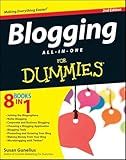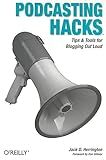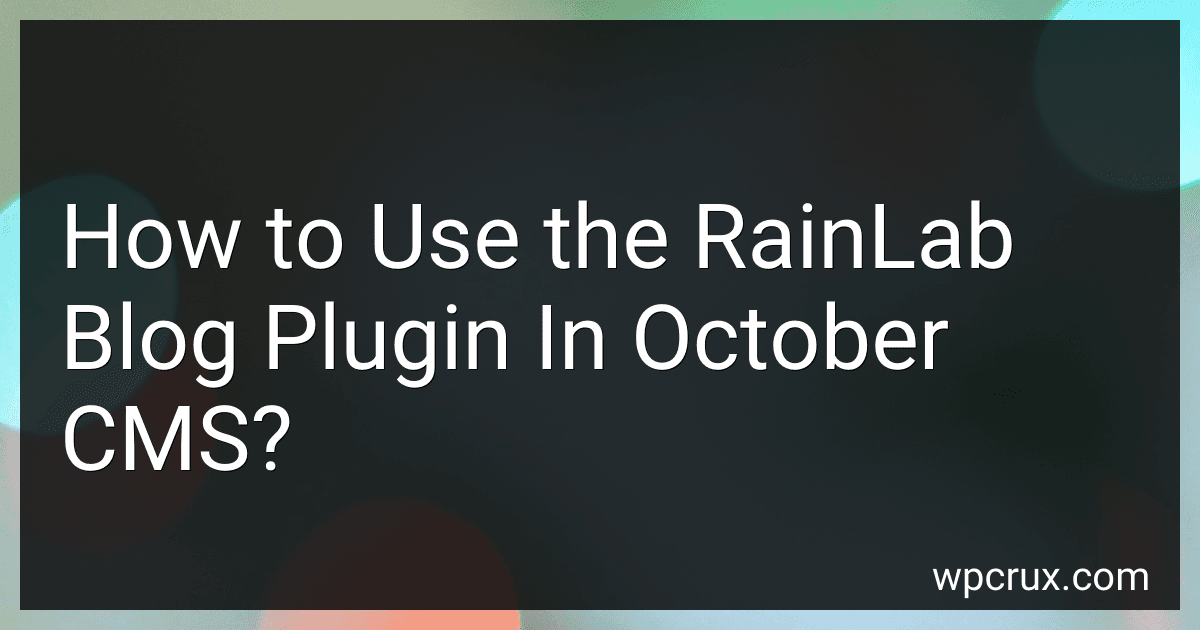Best Blogging Tools to Buy in October 2025

Blogging All-In-One for Dummies
- AFFORDABLE PRICING ON QUALITY USED BOOKS FOR BUDGET SHOPPERS.
- ECO-FRIENDLY CHOICE: REDUCE WASTE WITH RECYCLED LITERATURE.
- THOROUGHLY INSPECTED FOR QUALITY TO ENSURE A GREAT READING EXPERIENCE.



Six Figure Blogging Blueprint: How to Start an Amazingly Profitable Blog in the Next 60 Days (Even If You Have No Experience) (Digital Marketing Mastery Book 3)
- PREMIUM QUALITY FOR LASTING SATISFACTION AND PERFORMANCE.
- AFFORDABLE PRICING WITHOUT COMPROMISING ON VALUE AND RELIABILITY.
- ECO-FRIENDLY MATERIALS ENHANCE SUSTAINABILITY AND APPEAL.



Make a Killing With Content: Turn content into profits with a strategy for blogging and content marketing.



Blogging For Beginners: Turn Your Blog To A Money Machine: Blogging For Money, Blogging For Profit (Blogging, Blogging for Creatives, Blogging Business, Blogging For Beginners)



The AI Content Creator: Mastering ChatGPT for Blogging and Social Media



Podcasting Hacks: Tips and Tools for Blogging Out Loud
-
QUALITY ASSURANCE: EACH BOOK IS INSPECTED FOR GOOD CONDITION.
-
AFFORDABLE PRICING: ENJOY SIGNIFICANT SAVINGS ON PRE-OWNED TITLES.
-
SUSTAINABLE CHOICE: REDUCE WASTE BY OPTING FOR GENTLY USED BOOKS.



Food Blogging 101 – Your Recipe for Success: Tools, Techniques & Tips For Making Your Food Blog A Success From The Start



100+ Free Tools to Create Visuals for Web & Social Media (Free Online Tools)


The RainLab Blog plugin is a powerful tool that allows you to add a blog functionality to your October CMS website. Here are the steps to use the RainLab Blog plugin:
- Install the plugin: Log in to your October CMS backend, go to "Settings" and select "Updates & Plugins". Click on the "Install plugins" tab and search for "RainLab.Blog". Install the plugin and then click on "Return to plugins".
- Configure the plugin: After installing the plugin, go to "Settings" and select "Blog". Here, you can configure various settings such as the permalink format, number of posts per page, and allowing comments on posts.
- Create Categories: Categories help organize your blog posts. To create categories, go to "Blog" and select "Categories". Click on "Create" and provide a name for your category. You can also add a description and set a parent category if needed. Save the changes when you're done.
- Create a Post: To create a blog post, go to "Blog" and select "Posts". Click on "Create" and enter the title and content for your blog post. You can also add tags and select a category for the post. Save the changes when you're done.
- Customize the Blog Layout: You can customize the layout of your blog by modifying the files in the "themes" directory of your October CMS installation. The RainLab Blog plugin provides default templates that you can modify according to your needs.
- Displaying Blog Posts: To display the blog posts on your website, you can use the {% component %} tag in your layout file. For example, if you want to display recent blog posts, you can use {% component 'blogPosts' %}.
- Additional Features: The RainLab Blog plugin also offers additional features like managing authors, allowing user registration for commenters, and adding widgets such as a tag cloud or a most popular posts section.
By following these steps, you can easily use the RainLab Blog plugin in October CMS to create and manage your blog.
How to create a blog category using the RainLab Blog plugin?
To create a blog category using the RainLab Blog plugin, you can follow these steps:
- Install the RainLab Blog plugin: If you haven't already, install the RainLab Blog plugin on your OctoberCMS website. You can do this by navigating to the backend of your OctoberCMS site, going to the "Settings" section, clicking on "Updates & Plugins," and then searching for and installing the RainLab Blog plugin.
- Configure the plugin: After installing the plugin, you'll need to configure it. Go to the backend of your site, click on "Settings," and then click on "Blog" under the "RainLab Blog" section. Here, you can set up your blog settings, such as the post slug, post URL, etc., as well as enable blog categories.
- Enable categories: In the RainLab Blog plugin settings, under "Categories," make sure the "Enable Categories" option is checked. This will allow you to create and manage blog categories.
- Create a new category: After enabling categories, go back to the backend of your site and click on "Blog" under the "RainLab Blog" section. Here, you'll see the option to create a new category. Click on "New Category" to create a new blog category.
- Configure the category details: In the category creation page, you can give your category a name, slug (a URL-friendly version of the name), and optionally set a parent category if needed. You can also add a description and set a sort order for the category.
- Save and manage categories: Once you've configured the category details, click on the "Save" button to create the category. You can repeat this process to create multiple blog categories. You can also edit or delete categories as needed by going to the "Blog" section and clicking on the specific category to make changes.
By following these steps, you'll be able to create blog categories using the RainLab Blog plugin in OctoberCMS. These categories can then be used to organize your blog posts and make it easier for visitors to navigate and find relevant content.
What is the process of publishing a blog post in RainLab Blog?
To publish a blog post in RainLab Blog, you need to follow these steps:
- Install the RainLab Blog Plugin: Begin by installing the RainLab Blog plugin in your October CMS website. You can do this through the October CMS backend by navigating to Settings > Updates & Plugins > Install Plugins and searching for RainLab Blog.
- Create a Blog Post: Once the plugin is installed, go to the RainLab Blog section in the backend of your October CMS. Click on the "Posts" option and then select "Create New Post" to start creating a blog post.
- Fill in the Post Details: In the blog post creation form, enter the required information such as the post title, slug (URL-friendly version of the title), author, content, and other relevant details. You can also add tags, featured images, and specify the publication date and time.
- Review and Preview: After entering all the necessary details, review the blog post's content for any errors or inconsistencies. You can preview the post to see how it will look on the frontend by clicking the "Preview" button.
- Set Post Status: Choose the appropriate post status. By default, the post will be set to "Draft." If you are ready to make it live, select the "Published" status.
- Publish the Post: Once you have reviewed and are satisfied with the content, click on the "Save & Close" or "Save & Publish" button to publish the blog post. The post will now be visible on the frontend of your October CMS website.
- Modify or Update Published Posts: If you need to make changes to a published post, you can edit it from the RainLab Blog backend. Locate the post in the "Posts" section, click on it, make the necessary modifications, and save the changes.
That's how you can publish a blog post using RainLab Blog in October CMS.
How to customize the layout of a blog post in RainLab Blog?
To customize the layout of a blog post in RainLab Blog, you need to modify the templates provided by the RainLab Blog plugin. Follow these steps:
- Access the RainLab Blog plugin files: Login to your CMS backend and navigate to the "System" tab. Under the "Plugins" section, click on "RainLab.Blog" plugin.
- Locate the templates: In the plugin settings, click on the "Templates" option. Here you will find various templates for different sections of the blog. For post layout customization, you need to modify the "post.htm" template.
- Copy the template: To avoid losing your changes during future updates of the plugin, it is recommended to copy the "post.htm" template file to your active theme folder. To do so, click on the "Copy to theme" button next to the "post.htm" template.
- Modify the template: Navigate to your active theme folder (e.g., /themes/yourtheme) and find the "partials/blog/post.htm" file. Open it with a text editor or code editor of your choice.
- Customize the layout: Inside the "post.htm" file, you can modify the HTML structure, CSS styles, and add new elements according to your desired layout. Use HTML and Twig syntax to work with the dynamic content.
- Save the changes: After customizing the template, save the file.
Now, the layout of your blog post will be customized according to your modifications. Remember to clear the cache if necessary to see the changes take effect on the front-end of your website.
What is the process of creating a blog post draft in RainLab Blog?
To create a blog post draft in RainLab Blog, you can follow the steps below:
- Log in to the RainLab Blog backend interface by accessing your website's admin URL (usually yoursite.com/backend).
- Click on the "Blog" option from the left-hand sidebar menu.
- In the "Posts" tab, click on the "+ New Post" button located at the top-right corner of the screen.
- This will open a new page where you can start creating your blog post draft.
- Begin by entering a title for your blog post in the "Title" field at the top.
- In the "Content" field, you can use the text editor to write your blog post. You can format the text, add headers, styles, links, images, and more.
- Below the "Content" field, you can find some additional settings for your blog post, including a "Slug" field for the post's URL slug, "Excerpt" for a short preview of your post, and "Featured Image" to upload a representative image for the post.
- On the right-hand side, you have options to set the "Published" status, author, categories, tags, and any additional options specific to your setup.
- You can save your draft by clicking the "Save" button at the bottom-right corner of the page. This allows you to come back and edit the draft later.
- If you want to publish the blog post immediately, click the "Save & Close" or "Save & Publish" button instead.
That's it! You have created a blog post draft in RainLab Blog. You can always access and edit your drafts from the "Posts" tab in the RainLab Blog backend.
How to configure the sidebar in the RainLab Blog plugin?
To configure the sidebar in the RainLab Blog plugin, you can follow these steps:
- Open the backend of your OctoberCMS installation.
- Go to the "Settings" section.
- Click on the "Blog" option.
- In the "General" tab, you will find the "Sidebar Configuration" section.
- Enable the "Use Sidebar" option to activate the sidebar in your blog.
- Customize the available options as per your needs:
- "Limit Sidebar Entries": Set the number of blog posts to display in the sidebar.
- "Order Sidebar Entries By": Choose the sorting order for displaying blog posts in the sidebar.
- "Sidebar Title": Add a custom title for the sidebar section.
- "Sidebar Description": Provide a description that will be displayed above the blog posts in the sidebar.
- "Enable Categories and Tags Lists": Enable this option if you want to display the lists of blog post categories and tags in the sidebar.
- "Categories List Title" and "Tags List Title": Specify the titles for the categories and tags lists in the sidebar.
- "Enable Recent Posts List": Enable this option to show a list of recent blog posts in the sidebar.
- "Recent Posts Title": Add a custom title for the recent posts list in the sidebar.
- "Enable Popular Posts List": Activate this option to display a list of popular blog posts in the sidebar.
- "Popular Posts Title": Add a custom title for the popular posts list in the sidebar.
- After configuring the sidebar options, click on the "Save" button to save the changes.
Once you have completed these steps, the sidebar will be configured according to your settings in the RainLab Blog plugin.
